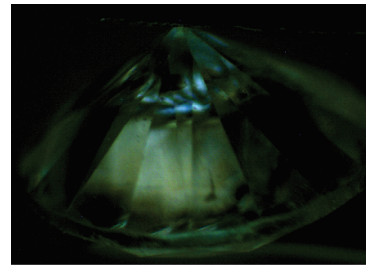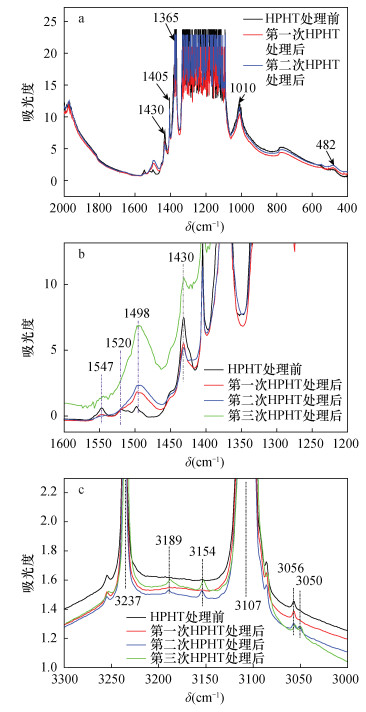| [1] |
Hainschwang T.HPHT treatment of different classes of typeⅠ brown diamond[J].Journal of Gemmology, 2005, 29(5/6):261-273.
Google Scholar
|
| [2] |
King J M, Shigley J E, Gelb T H, et al.Characterization and grading of natural-color yellow diamonds[J].Gems & Gemology, 2005, 41(2):88-115.
Google Scholar
|
| [3] |
宋中华, 魏华, 田晶.钻石辨假[M].北京:文化出版社, 2017.
Google Scholar
Song Z H, Wei H, Tian J.Identification of Diamonds[M].Beijing:Cultural Development Press, 2017.
Google Scholar
|
| [4] |
Collins A T.The colour of diamond and how it may be changed[J].Journal of Gemmology, 2001, 27(6):341-359. doi: 10.15506/JoG.2001.27.6.341
CrossRef Google Scholar
|
| [5] |
Schmetzer K.Clues to the process used by general electric to enthance the GE Pol diamonds[J].Gems & Gemology, 1999, 35(4):186-190.
Google Scholar
|
| [6] |
Fisher D, Spits R A.Spectroscopic evidence of GE pol HPHT-treated natural type Ⅱa diamonds[J].Gems & Gemology, 2000, 36(1):42-49.
Google Scholar
|
| [7] |
Reinitz I M, Buerki P R, Shigley J E, et al.Identification of HPHT-treated yellow to green diamonds[J].Gems & Gemology, 2000, 36(2):128-137.
Google Scholar
|
| [8] |
Collins A T, KandaH, Kitawaki H.Colour changes pro-duced in natural brown diamonds by high-pressure, high-temperature treatment[J].Diamond and Related Materials, 2000(9):113-122.
Google Scholar
|
| [9] |
宋中华, 陆太进, 苏隽, 等.无色-近无色高温高压合成钻石的谱图特征及其鉴别方法[J].岩矿测试, 2016, 35(5):496-504.
Google Scholar
Song Z H, Lu T J, Su J, et al.The spectral characteristics and identification techniques for colorless and near-colorless HPHT synthetic diamonds[J].Rock and mineral Analysis, 2016, 35(5):496-504.
Google Scholar
|
| [10] |
Schmetzer K.High pressure and high temperature treatment of diamonds-A review of the patent literature from five decades[J].The Journal of Gemmology, 2010, 32(1-4):52-65. doi: 10.15506/JoG.2010.32.1-4.52
CrossRef Google Scholar
|
| [11] |
Fisher D.Brown diamonds and high pressure high tem-perature treatment[J].Lithos, 2009, 112S:619-624.
Google Scholar
|
| [12] |
宋中华, 陆太进, 苏隽, 等.利用吸收和发光光谱技术分析高温高压处理天然富氢钻石的鉴定特征[J].岩矿测试, 2018, 37(1):64-69.
Google Scholar
Song Z H, Lu T J, Su J, et al.Identification of HPHT-treated hydrogen-rich diamonds optical absorption and photo luminescence spectroscopic techniques[J].Rock and Mineral Analysis, 2018, 37(1):64-69.
Google Scholar
|
| [13] |
宋中华, 陆太进, 苏隽, 等.不同类型褐色钻石的高温高压处理结果初析[C]//中国国际珠宝首饰学术交流会论文集, 2017: 15-17.http://www.ykcs.ac.cn/article/doi/10.15898/j.cnki.11-2131/td.201705040072
Google Scholar
Song Z H, Lu T J, Su J, et al.HPHT-treated Experiment for Different Types of Brown Diamonds[C]//Proceedings of China International Gems & Jewelry Academic Conference, 2017: 15-17.
Google Scholar
|
| [14] |
DeWeerdt F, Collions A T.The influence of pressure on high-pressure, high-temperature annealing of type Ⅰa diamond[J].Diamond and Related Materials, 2003, 12:507-510. doi: 10.1016/S0925-9635(02)00319-9
CrossRef Google Scholar
|
| [15] |
Collions A T.The detection of colour-enhanced and synthetic gem diamonds by optical spectroscopy[J].Diamond and Related Materials, 2003, 12:1976-1983. doi: 10.1016/S0925-9635(03)00262-0
CrossRef Google Scholar
|
| [16] |
Fritsch E, Hainschwang T, Massi L, et al.Hydrogen-related optical centers in natural diamond-An update[J].New Diamond and Frontier Carbon Technology, 2007, 17(2):63-89.
Google Scholar
|
| [17] |
Breeding C M, Eaton-Magaña S, Shigley J E.Natural-color green diamonds:A beautiful conundrum[J].Gems & Gemology, 2018, 54(1):2-27.
Google Scholar
|
| [18] |
Fritsch E, Scarratt K V G.Optical properties of some natural diamonds with high hydrogen content[J].Diamond Optic Ⅱ, 1989, 1146:201-206.
Google Scholar
|
| [19] |
Massi L, Fritsch E, Collins A T, et al.The "amber centres" and their relation to the brown colour in diamond[J].Diamond and Related Materials, 2005, 14:1623-1629. doi: 10.1016/j.diamond.2005.05.003
CrossRef Google Scholar
|
| [20] |
Dobrinets I A, Vins VG, Zaitsev A M.HPHT-treated diamonds[EB/OL].2013.
Google Scholar
|
| [21] |
Baker J M.A new proposal for the structure of platelets in diamond[J].Diamond and Related Materials, 1998, 7:1282-1290. doi: 10.1016/S0925-9635(98)00188-5
CrossRef Google Scholar
|
| [22] |
Goss J P, Briddon P R, Hill V, et al.Identification of the structure of the 3107cm-1 H-related defect in diamond[J].Journal of Physics:Condensed Matter, 2014, 26:1-6.
Google Scholar
|
| [23] |
Woods G S.Platelets and the Infrared Absorption of Type Ⅰa Diamonds[C]//Proceedings of the Royal Society of London, 1986: 219-238.
Google Scholar
|
| [24] |
Hainschwang T, Fritsch E, Massi L, et al.The C center isolated nitrogen-related infrared absorption at 2688cm-1:Perfect harmony in diamond[J].Journal of Applied Spectroscopy, 2012, 79(5):737-743. doi: 10.1007/s10812-012-9664-5
CrossRef Google Scholar
|
| [25] |
Tretiakova L.Spectroscopic methods for the identification of natural yellow gem-quality diamonds[J].European Journal of Mineralogy, 2009, 21:43-50. doi: 10.1127/0935-1221/2009/0021-1885
CrossRef Google Scholar
|
| [26] |
Buerki P R, Reinitz I M, Muhlmeister S, et al. Observation of the H2 defect in gem-quality type Ⅰa diamond[J].Diamond and Related Materials, 1999, 8:1061-1066. doi: 10.1016/S0925-9635(99)00094-1
CrossRef Google Scholar
|
| [27] |
Hainschwang T, Notari F, Fritsch E, et al.Natural, un-treated diamonds showing the A, B and C infrared absorptions ("ABC diamonds"), and the H2 absorption[J]. Diamond and Related Materials, 2006, 15:1555-1564. doi: 10.1016/j.diamond.2005.12.029
CrossRef Google Scholar
|
| [28] |
Goss J P, Jones R.Properties, Growth and Applications of Diamond[M].London:INSPEC, IEEE, 2001.
Google Scholar
|
| [29] |
Collions A T.Vacancy enhanced aggregation of nitrogen in diamond[J].Journal of Physics C:Solid State Physics, 1980, 13:2641-2650. doi: 10.1088/0022-3719/13/14/006
CrossRef Google Scholar
|
| [30] |
Wang W Y, Mose T M.Gem quality CVD synthetic dia-monds from gemesis[J].Gems & Gemology, 2011, 71(3):227-228.
Google Scholar
|







 DownLoad:
DownLoad:


